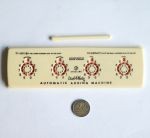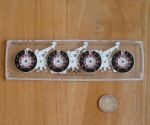



Sterling Dial-A-Matic
The IBM Hexadecimal Adder
The see "calculator"
Videos
Newspaper and Magazine Advertisements
Patents
Links
The Dial-A-Matic is 4-dial adder made by Sterling Plastics Co., based in Union, New Jersey. Sterling mostly made school and office equipment such as protractors, slide rules, pencil cases, and filing card boxes.
The Dial-A-Matic is made of cream-coloured plastic and comes with a plastic stylus of the same colour. Like the Kes-Add, the dials can be moved in both directions, and in either case the carry operations also work as they should. The stylus should have a longer thin tip, but this easily breaks off making it fairly useless.
They were usually packaged in a cardboard box, as shown here, though blister packaging was used in later years.
The carry is transferred through an intermediate wheel. There is a mechanism that
prevents a wheel from overshooting when it receives a carry - the lever above the
driven wheel gets pushed up, and the other end comes down and halts the rotation of
the wheel that recieved the carry.
It was patented by Otto Lehre at Sterling Plastics Co. in April 1954. The
trademark for the Dial-a-matic logo was filed in January 1955, and the filing states
that its first commercial use was on October 10, 1954.
It seems to have been in production for 15 years, until about 1970. Some versions were made for other companies, usually for advertising. There is for example a "Dial-a-Chevy" version for Chevrolet.
Sterling made a few variations: model 565 is the standard 4-dial version above, model 566 a yellow 4-dial version built into the lid of a pencil box, model 567 a 5-dial version, and lastly model 568 is a 6-dial version. The 5 and 6-dial versions had an angled base for use on a desk. A toy 3-dial version was also made in later years, but I don't know its model number.
The 6-dial version has a clearing mechanism, activated by pulling out a spring-loaded tab on the right hand side.
This is a version made specially for IBM. There are four dials which all have 16 positions marked 0 to 9 and A to F. These can be used to add and subtract four-digit hexadecimal numbers. It was made in the late 1960s, and was used by programmers of machines such as the IBM 360, which had 16-bit memory addresses. This version is slightly wider and thicker than a standard Dial-a-matic, and is supplied with a durable metal stylus which can be stored in a hole at the right hand side.
Apparently the idea to make a hexadecimal version of a dial adder came from Carl J. Lombardi, who was one of the IBM field engineers. In the late 1960s IBM got Sterling to make a batch of these machines which were then issued to their field engineers. The adder has no mention of Sterling anywhere, but does have the list of patents on the back.
This is a version of the Sterling Dial-A-Matic in which the outer case was made from transparent plastic, making the mechanism fully visible. It was made in 1968 for selective educational equipment inc., hence the name see. This company was based in Newton, Massachusetts, and supplied all kinds of equipment and books for use in school lessons. This must have been made by Sterling, because on the back it has the same raised lettering stating the Sterling model number and listing the patent numbers that the normal Dial-A-Matic has. The front carries the same instructions.
In 1982 the transparent Dial-A-Matic was reissued by the Burt Harrison & Co. of Weston, Mass. with the name Pascal-type Calculator.
Below is a video I made that demonstrates the Dial-A-Matic and the SEE calculator.
This video shows the 6-dial Dial-A-Matic with clearing mechanism.
Here are some of the advertisements I found in online archives.
Here is the trademark registration of the "DIAL-A-MATIC" logo, filed 4 January 1955, from the USPTO's official gazette. The logo and filing info can be found on the USPTO site.
| Patent | Filing date | Published date | Name | Description |
|---|---|---|---|---|
| US 2,797,047 | 30-04-1954 | 25-06-1957 | Otto Lehre (Sterling Plastics Co.) | Dial-A-Matic
See also: CA 556,754, GB 773,099. |
© Copyright 2019-2020 Jaap Scherphuis, mechcalc a t jaapsch d o t net.